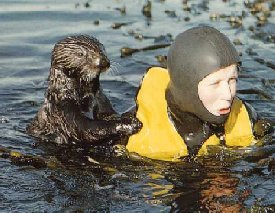What Features Would be Expected in a Semi-Aquatic Ape?
Do We Have them?
|
The Diving Reflex and Vasoconstriction
The "Diving Reflex", bradycardia, is a condition which occurs to the greatest degree in
semi-aquatic and fully aquatic animals. It involves a decrease in heart rate and
redistribution of blood through the body (vasoconstriction), to the brain and essential
organs. It has been shown that for
trained humans the diving response is equivalent to a semi-aquatic shallow diving mammal
(Schagatay and Holm 1996). Experimental trained human dives included 40m depths for 2 minutes,
and 7 min apneas at rest. It was also found that in humans the diving response is brought about
by chilling the upper face (Schuitema and Holm 1988). Recent experiments have shown that the
diving reflex, depends not so much on "absolute" water temperature, but more so on the
"difference between ambient and water temperature" (Schagatay and Holm 1996).
An interesting fact coming out of this research was that the diving reflex of a trained pig
(an ex-aquatic), is equal to that of an untrained human. Much of Schagatay's research involves
the Sea People of Indonesia, and the Ama in Korea and Japan.
|

 |
While it is true that the diving reflex is present
in almost all vertebrates, it is the degree to which it is voluntarily manifested which
separates diving animals with non-aquatic species. Experiments with dolphins and seals
trained to dive to retrieve particular items, show they will gauge the distance and time required to
get the article, and hold their breath accordingly. This in turn affects the bradycardia, and vasoconstriction. It has been
found that when seals and dolphins are submerged involuntarily the magnitude of the diving
reflex is greatly increased (Morgan 1997). This implies that the animals estimate the required amount
of air for a particular dive, and heart rate responds accordingly. When submerged involuntarily the
animal has no idea when it will breathe again and heart rates fall to a greater degree than when the
animal dives under normal conditions. In the case of the sea lion, when voluntarily diving, the heart rate
averaged about 40 beats
per minute, when held under against its will, the heart rate fell to 8 beats per minute (Morgan 1997).
This is similar to the effect when a purely terrestrial mammal is submerged, they generally cannot
be trained to consciously hold their breath, thus their "diving reflex" is always greatly
exaggerated. They think they are going to drown.
However, this alone cannot explain why we can and do speak.
Voluntary override of the autonomic breathing reflex must have taken place, and been
advantageous for the species involved. It is important to note that communication among aquatic animals is often sound based.
Humans communicate through sound, facial and body expressions, just as the other primates do.
However, the extent to which both vocal and facial communication has evolved in Homo sapiens is not
matched anywhere else in the primate family. If we consider a semi-aquatic episode, we have a reason
for this behavioural change. When in water, most of the body is hidden, making body language useless as a
tool for communicating (Morgan 1997). Our ancestor would have had to rely on something else to warn of danger
or otherwise communicate with members of its group.
Again, this begs the question: What kind of environment did our ancestors evolve in (or were forced to
exploit), that would
force them to begin holding their breath and diving? If we go by the old chain of
thought, a dry savanna, why would we possibly adopt a character that would, in that
environment, serve no useful purpose? Even the model of the new "mosaic", (woodland/forests)
does not provide the enormous stress required to acquire these features (Verhaegen and Oser 1997).
Next
Back to Contents
Back

